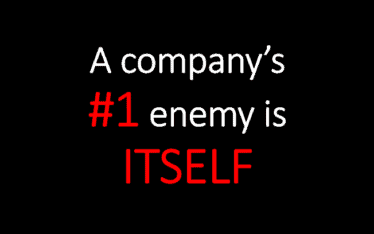In the industrial age, a company’s business model didn’t change much
In the industrial age, a company’s business model didn’t change much. The way a company would create, deliver and capture value could stay fairly constant for generations. The practice of management was mostly focused on execution. If you could move men and material efficiently, buy for a dollar and sell for two, you’d be successful, sometimes enormously so.
Now disruption is rampant
But that’s no longer true. With scale advantages disappearing, no one is immune. Disruption is rampant – change is now an inevitable part of the modern business environment.
Today’s business environment is characterized by rapid, extensive change and unpredictability. The combined effects of digitization, connectivity, globalization, demographic shifts, and social feedback are shaking the foundations of almost all businesses, making sustained growth more valuable and elusive than ever before
Of the 500 companies on Fortune’s original list of the largest companies in 2008:
- Of the 500 companies that appeared on the first list, in 1955, only 71 hold a place on the list in 2008.
- Nearly 2,000 companies have appeared on the list since its inception, and most are long gone from it. Just because you make the list once guarantees nothing about your ability to endure.
- Some of the most powerful companies on today’s list – businesses like Intel, Microsoft, Apple, Dell, and Google – grew from zero to great upon entirely new technologies, bumping venerable old companies off the list.
Upstarts can get access to resources that used to be available only to large ones. Whether it’s infrastructure in the cloud, outsourced manufacturing or capital from angels, VC’s and crowdfunding, very few industries still have significant barriers to entry.
The French author Andre Gide wrote:
Man cannot discover new oceans unless he has the courage to lose sight of the shore
In very much the same way, we can’t manage strategy in the 21st century without discarding the comfortable dogmas of the 20th century.
Organizations, and the people within them, must constantly re-invent themselves to remain competitive. Sustaining success depends on an organization’s ability to adapt to a changing environment.
Business model innovation in times of rapid change
One of the key components of transformation and innovation is the business model, and since the ability of companies to transform and reinvent themselves is crucial to their lifeline,
Many large companies today don’t always understand their current business model very well, let alone be thinking of what the next one will be.
Yet, it is the ability to both execute on the current business model while thinking of the business model of tomorrow that will ultimately be the difference between a company that is a one hit wonder and one that is here to stay.

Embed code:
Click here to get this infographic (HTML) for your website
Short URL & title:
Business models don’t last as long as they used to — http://www.torbenrick.eu/t/r/bkn
Share it:
If you enjoyed this article, please take 5 seconds to share it on your social network. Thanks!








This is so true. I see my clients struggle with changing their business models because neither the leadership nor the employees understands the new path to follow. The leaders become so embroiled in change conflict that they can’t get into a leadership position.
I guess this is great news for those of us who make our living helping clients through the change.
exactly what the French writer Andre Gide , that “Man can not discover new oceans unless he has the courage to forget the beach”
All change begins with the first step, and the first step is the hardest thing to leave the comforts we have.
Insightful article